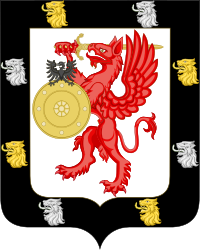
Back Huis van Romanof Afrikaans عائلة رومانوف Arabic Dinastía Romanov AST Romanovlar sülaləsi Azerbaijani Раманавы Byelorussian Раманавы BE-X-OLD Романови Bulgarian Dinastija Romanov BS Dinastia Romànov Catalan بنەماڵەی ڕۆمانۆڤ CKB
| House of Romanov Романовы | |
|---|---|
 Argent, a griffin gules, holding in its right paw a sword, in the left an oval buckler or, on it an eagle displayed sable; the whole within a bordure of the last charged with eight lion's heads erased, alternately of the first and the third.[1] | |
| Parent house | Schleswig-Holstein-Gottorp (since the mid-18th century)[a] |
| Country | |
| Founded | 21 February 1613 |
| Founder | Michael I |
| Current head |
|
| Final ruler |
|
| Titles |
|
| Connected families | Schleswig-Holstein-Gottorp, House of Windsor, Saltykov family, Rakhmanov |
| Deposition | 15 March 1917 (Russian Revolution) |
| Cadet branches | Several minor branches |
The House of Romanov[b] (also transliterated as Romanoff; Russian: Рома́новы, romanized: Romanovy, IPA: [rɐˈmanəvɨ]) was the reigning imperial house of Russia from 1613 to 1917. They achieved prominence after Anastasia Romanovna married Ivan the Terrible, the first crowned tsar of all Russia. Nicholas II, the last Emperor of Russia, and his immediate family were executed in 1918, but there are still living descendants of other members of the imperial house.
The house consisted of boyars in Russia (the highest rank in the Russian nobility at the time) under the reigning Rurik dynasty, which became extinct upon the death of Feodor I in 1598. The Time of Troubles, caused by the resulting succession crisis, saw several pretenders and imposters lay claim to the Russian throne during the Polish-Lithuanian occupation. On 21 February 1613, the Zemsky Sobor elected Michael Romanov as tsar, establishing the Romanovs as Russia's second reigning dynasty.
Michael's grandson, Peter I, who took the title of emperor and proclaimed the Russian Empire in 1721, transformed the country into a great power through a series of wars and reforms. The direct male line of the Romanovs ended when Elizabeth died childless in 1762. As a result, her nephew Peter III, an agnatic member of the House of Holstein-Gottorp (a cadet branch of the German House of Oldenburg that reigned in Denmark), ascended to the throne and adopted his Romanov mother's house name.[9] Officially known as members of the House of Romanov, descendants after Elizabeth are sometimes referred to as Holstein-Gottorp-Romanov.[10]
Paul I became the first heir to the throne, having the title tsesarevich, which was subsequently used for all main heirs.[11]
The abdication of Nicholas II on 15 March [O.S. 2 March] 1917 as a result of the February Revolution ended 304 years of Romanov rule and led to the establishment of the Russian Republic under the Russian Provisional Government in the lead-up to the Russian Civil War of 1917–1922. In 1918, the Bolsheviks executed Nicholas II and his family. Of the House of Romanov's 65 members, 47 survivors went into exile abroad.[12] In 1924, Grand Duke Kirill Vladimirovich, the senior surviving male-line descendant of Alexander II of Russia by primogeniture, claimed the headship of the defunct Imperial House of Russia.
- ^ Woodward, John (1896). A Treatise on Heraldry, British and Foreign: With English and French Glossaries. W. & A. K. Johnston. p. 339. Retrieved 10 August 2024.
- ^ "Head of the Russian Imperial House, Her Imperial Highness the Grand Duchess (de jure Her Imperial Majesty the Empress of all Russias) Maria Wladimirovna". Russian Imperial House. Retrieved 27 September 2024.
- ^ "Prince Alexis Romanoff". 19 August 2023.
- ^ "Obituary: Prince Andrew Andreevich Romanoff (1923-2021)". 29 November 2021.
- ^ Obituaries, Telegraph (17 January 2022). "Prince Andrew Romanoff, grandnephew of Russia's last czar who became an artist in the US – obituary". The Telegraph.
- ^ "Ушёл из жизни «последний настоящий Романов» | Русская Культура". 2 December 2021.
- ^ "The Imperial House of Russia, House of Romanov".
- ^ "The Heir to the All-Russian Emperorship, His Highness Prince of the Imperial Blood Nikolay Kirillovich of Russia, Prince zu Leiningen". The Imperial Heraldy. Retrieved 6 January 2022.
- ^ Montgomery-Massingberd, Hugh. "Burke's Royal Families of the World: Volume I Europe & Latin America, 1977, pp. 460–476. ISBN 0-85011-023-8
- ^ "Просмотр документа – dlib.rsl.ru". rsl.ru.
- ^ Цесаревич Павел Петрович (1754-1796) (in Russian).
- ^ Isaeva, Ksenia (25 March 2015). "Dmitri Romanov: Immigration, friendship with Coco Chanel, the Olympics". Retrieved 30 November 2016.
Cite error: There are <ref group=lower-alpha> tags or {{efn}} templates on this page, but the references will not show without a {{reflist|group=lower-alpha}} template or {{notelist}} template (see the help page).